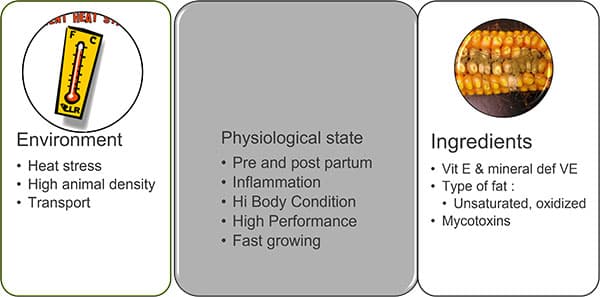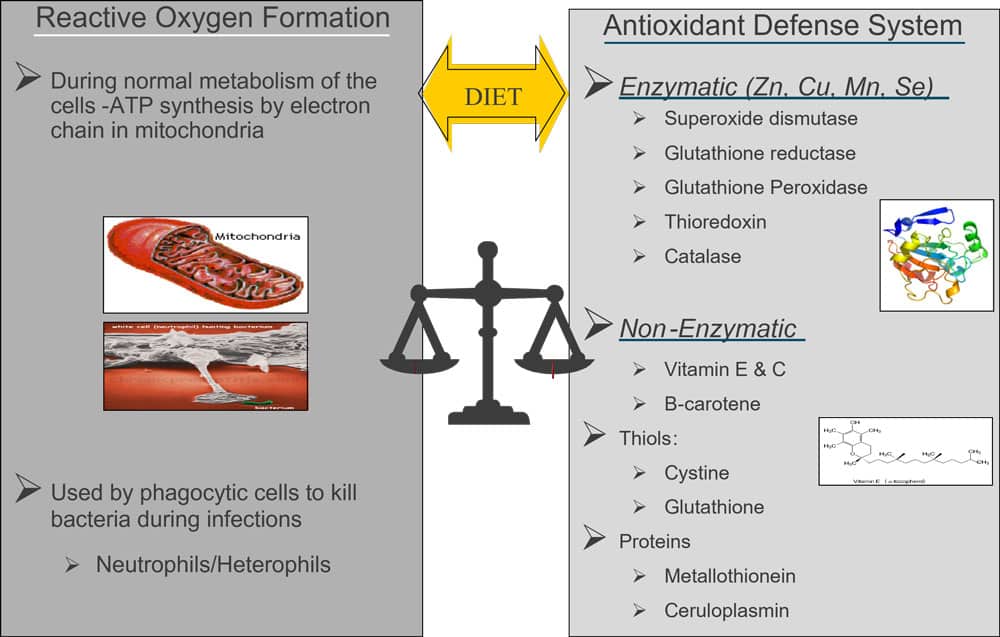By Shawn Ma, Regional Technical Manager – Swine, EW Nutrition
Increasing human demand for animal products has led to the need for animals to produce as much as possible efficiently with limited time, land, and food resources. This has resulted in the need for high-quality feed, adequate nutrition, and strict management to ensure that the animal body is in a healthy state. The organism will have more stringent requirements for energy use and distribution, will use more nutrients for production, and will accept only reduced or little change in maintenance needs to guarantee the normal survival of the organism. In the last two years, raw materials have been affected by several factors that have led to a decline in quality, while the shortage and higher prices of raw materials have led producers to take various measures to compensate for the effects of the above factors, such as the dangers of mycotoxins, feed antioxidants and the heavy use of wheat and grain by-products.
Under the action of the factors mentioned in figure 1, the animal organism will produce a large number of oxygen radicals, and the accumulation of oxygen radicals will cause damage to the organism and a decrease in production performance.
 Figure 1: Factors promoting oxidative stress
Figure 1: Factors promoting oxidative stress
Feed oxidation can cause damage to the organism
The role of adding fats and oils to pig diets is mainly to increase energy, provide essential fatty acids, improve feed palatability, reduce dust, and improve pellet quality (Keer et al., 2015). Some feed ingredients are more susceptible to oxidation due to their physical and chemical properties, such as milled grains, animal-derived ingredients, and vegetable oils with high levels of polyunsaturated fatty acids.
Oxidative rancidity is an oxidative degradation of lipids. During oxidation, free radicals react with lipids and proteins and induce cellular and tissue damage. The consequence of oxidative rancidity is the destruction of fat-soluble vitamins and oils. The oxidation process also produces unpleasant odors and even toxic metabolites. In addition, oxidized feeds are lower in protein, amino acids, and energy.
Free radicals and the endogenous antioxidant capacity should be in balance
The oxygen molecule is a stable diatomic structure, but under the influence of some factors, the oxygen atom will lose an electron, transforming harmless oxygen probably into a lethal oxygen radical. In the body, there is a natural balance between the free radicals produced by normal cell metabolism and the endogenous antioxidant capacity of the animal, which can prevent the accumulation of free radicals and damage to cells. However, if the level of free radicals exceeds the animal’s antioxidant capacity, oxidative stress can occur. Reactive oxygen species (ROS) mainly attack tissues or organs with a high unsaturated fatty acid content, such as cell membranes. Since the main component of the cell membrane is a highly unsaturated phospholipid bilayer, it is extremely vulnerable to oxygen radical attack.
 Figure 2: Balance between reactive oxygen formation and antioxidant defense system
Figure 2: Balance between reactive oxygen formation and antioxidant defense system
Endogenous antioxidant substances support the organism
To remove oxygen radicals from the body, we usually add exogenous antioxidant substances. Antioxidants are essential feed additives for feed production, which not only prevent the oxidation and/or rancidity of vitamins, minerals, and lipids in vitro but also enter the body to scavenge oxygen radicals, improve energy utilization and maintain animal health.
Natural antioxidants used are, e.g., Vitamin C, Vitamin E, selenium, and tea polyphenols. Among them, Vitamin C can consume oxygen and avoid the oxidation of active ingredients. Vitamin E can participate in the formation of cell membranes, and phenolic structures can bind oxygen. Selenium is mainly involved in the formation of glutathione peroxidase to remove peroxides. Other natural ingredients such as tea polyphenols have a better antioxidant effect, but the cost is higher.
There are also five kinds of chemically synthesized antioxidants used in feed and animal production, and they are used in the form of monomers or compounds. Generally speaking, the effect of compound products is higher than that of monomers. Compared with other antioxidants, chemically synthesized antioxidants react quickly with oxygen radicals to produce low-energy substances, which interrupt electron transfer and make the scavenging of oxygen radicals more efficient.
| Ethoxyquin | BHA | BHT | TBHQ | PG |
| 1,2-dihydro-6-ethoxy-2,2,4-tri-methyl quinoline | Butyl hydroxy-anisole | Dibutyl hydroxy-toluene | Tert-butyl-hydroquinone | Propyl Gallate |
| The most effective antioxidant substance, followed by BHT and BHA | Effective in animal oils, ineffective in vegetable oils | Effective in animal oils, weak in vegetable oils (better than BHA) | More effective in vegetable oils | Synergistic use with other natural and synthetic antioxidants |
Agrado is an optimal combination of synthetic antioxidants
Agrado contains high concentrations of ethoxy quinoline and propyl gallate, which effectively prevent the oxidation of vitamins and fats, efficiently scavenge oxygen radicals in the body, improve animal growth performance, and improve meat quality.
The ORAC assay measures the fluorescence signal from a probe bursting in the presence of reactive oxygen species (ROS) and, therefore, shows the antioxidant capacity of a substance. The addition of an antioxidant absorbs the generated ROS, thus perpetuating the fluorescence signal. In the ORAC assay, the antioxidant capacity of any compound is compared to Trolox, a vitamin E analog and known antioxidant, which is used as the standard against which all other antioxidants are compared.
 Figure 3: ORAC test showing a higher antioxidant capacity for Agrado than for Vit. E analog
Figure 3: ORAC test showing a higher antioxidant capacity for Agrado than for Vit. E analog
Agrado improves growth performance in pigs
As already mentioned, oxidative stress decreases performance, meaning that reducing oxidative stress should increase growth performance. To check if Agrado mitigates oxidative stress, grower/finisher pigs were fed a diet containing oxidized fats. For this purpose, five groups were created and the diets contained the following:
NC (negative control): oxidized fat, no antioxidant
Vit. E: oxidized fat; 11 I.U. of Vitamin E/kg of feed
Agrado: oxidized fat; 250g of Agrado/t of feed
Agrado + Vit. E: oxidized fat; 250g of Agrado/t and 11 I.U. of Vitamin E/kg of feed
FF: fresh fat in the diet
The results are shown in Figure 5. The group receiving oxidized fats in the diet showed a lower body weight during all phases of fattening. The groups receiving Agrado or the combination of Agrado and Vitamin E always showed a body weight like the group receiving non-oxidized fats and at least numerically better results than the Vitamin E group.
 Figure 4: Influence of antioxidants on growth performance
Figure 4: Influence of antioxidants on growth performance
Agrado prevents the production of yellow fat in pigs
The production of yellow fat, unfortunately, occurs very often in China, especially in pigs on stale grain in summer. The high temperature in summer, the high fatty acid value, and the mycotoxins in the aged grain lead to intense oxidative stress in pigs. The same trial as mentioned before showed that the addition of vitamin E (Vit. E) at the NRC recommendation of 11 IU was not effective in preventing yellow fat production. However, feeding Agrado at a dosage of 250 g/t or Agrado (250g/t) in combination with vitamin E (11 IU/kg) was effective in preventing yellow fat production. With Agrado, it is, therefore, possible to produce the desired white fat in pigs even during periods such as summer with high temperatures and a not-optimal composition of the feed

Figure 5: Fat samples of pigs fed Vitamin E and Agrado as antioxidants
Agrado compensates for the negative effects of DDGS
To show the positive effects of Agrado in pigs receiving a diet with DDGS, a trial with about 1000 nursery pigs was conducted. Days 10 to 42 implemented fat treatment. Three different fat sources were used:
| Fresh | fresh corn oil |
| Oxidized: | 7.5 meq PV/kg final diet |
| DDGS | 20% DDGS from day 10-21 post-weaning
30% DDGS from day 22-42 post-weaning |
 Figure 6: Agrado mitigates the negative effects of oxidized fat and DDGS in the diet
Figure 6: Agrado mitigates the negative effects of oxidized fat and DDGS in the diet
Conclusion
Intensive production conditions led to a higher risk for oxidative stress in farm animals impacting health and production performance. With the shortage of corn and soybean meal in recent years, the use of wheat and mixed meal ingredients has increased the challenge of anti-nutritional factors and consequently also oxidative stress. Harmful substances such as mycotoxins, cause serious damage to the liver, kidneys, and other organs so that the body’s ability to resist oxidative stress is strongly reduced.
Antioxidant products like Agrado can help to mitigate oxidative stress, leading to a stabilization or even improvement of production performance and higher meat quality.
